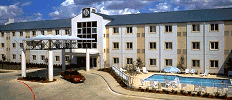| The first property in Florida to get the "Motel
of the 21st Century" design, as it is called, is at 5909 Americana Way,
off International Drive in Orlando.
Accor, the French-based owner of the chain since 1990, turned to Fugleberg
Koch architects in Winter Park for help with the re-imaging project in
the late 1990s. The prototype was created in 2000 and gradually rolled
out in all new construction during the past two years.

Motel 6 Prototype
|
Fugleberg Koch, coincidentally founded one year after Motel 6 was born
in 1962, had earned a reputation for other successful re-imaging projects
in the 1990s such as for LaQuinta Inns and for creative work on upscale
hotels and major resorts worldwide.
One of the main challenges, Fugleberg Koch representatives said, was
to craft a contemporary look with "visual impact at an economic level."
To do that, they employed spacious modular bathrooms, new energy-efficient
air-conditioning systems, dataports in every room, electronic door locks,
outside security cameras and other touches that bring the chain into the
modern era without breaking the bank.
Accor, which has its North American headquarters in Dallas, operates
more than 800 Motel 6s in the United States and Canada. As new units are
built and old ones are torn down, all new outlets for the foreseeable future,
company representatives said, will feature the Central Florida-born design.
|
Motel 6 and franchisees are building several examples
of this new prototype in various sizes and configurations throughout the
country.
Interior Corridors.
The traditional motel, with its exterior doors, has undeniable
convenience in terms of guest access to and from an automobile. However,
it has drawbacks which are increasing in importance to the motel operator
and his guests. During entry and exit, the guestroom is "open to the world"
and heat and cool escapes to the atmosphere. Except in "paradise climates,"
this consumes a lot of energy, and utilities are not getting cheaper. At
Motel 6, with a large number of exterior-door motels, we have spent over
8% of our revenues on utility bills. Clearly, an interior-corridor design
is a more efficient user of energy, and a convenience to guests in extreme
weather. Access to rooms can be more carefully controlled. And, it is not
more expensive to build!
Maintenance costs can be reduced also. An interior-corridor
design does not expose every door to the weather, or place as much emphasis
on proper door sealing. Interior hallways do not have to be cleared of
snow, or their railings checked for security or constantly repainted to
hide rust.
A taller motel.
Every hotel or motel developer faces the same set of height
design concerns. A tall building uses less land and is easier to see from
a distance. A single-story building needs less emphasis on structural integrity
but its "footprint" causes management, guest convenience, and land-cost
problems. Starting with a clean sheet of paper, we studied all the alternatives,
and we believe the three-story version of our prototype building hits the
"sweet spot" among all the alternatives.
As the low-price leader, we are of course concerned with
development cost. And in most areas, "stick" (wood-frame) construction
is by far the most cost-efficient for motels, but its practical limit is
a three-story design; buildings of four or five stories require more expensive
concrete or masonry construction. Unless land cost is extremely high, the
wood-frame building yields the most "bang for the buck." We recommend three
stories for structures of 60 rooms or more, which saves over 6,000 square
feet of land compared to a two-story equivalent.
Finally, it's very important that a potential guest exiting
the freeway can see the property. Signs help, but a taller building can
simply be seen from further away - even if it's on the less expensive site
behind a one-story restaurant. Our building design incorporates built-in
signage opportunities. |
|


